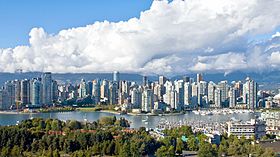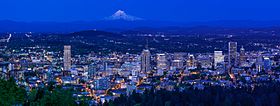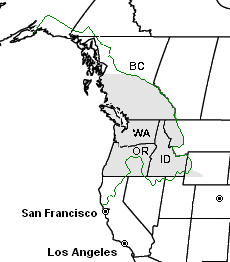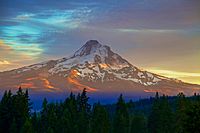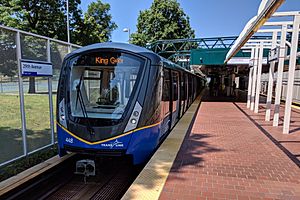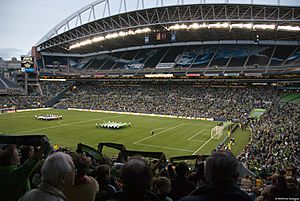Pacific Northwest facts for kids
Quick facts for kids
Pacific Northwest
Cascadia |
|
|---|---|
|
Left-right from top: Seattle skyline and Mount Rainier, the Palouse, Crater Lake, Vancouver skyline, the Black Tusk, Cannon Beach, Portland skyline and Mount Hood
|
|
| Composition |
|
| Largest metropolitan areas |
|
| Dialect | Pacific Northwest English |

The Pacific Northwest (often called PNW) is a cool region in western North America. It's bordered by the Pacific Ocean on the west and the Rocky Mountains on the east. There's no exact border, but it usually includes the U.S. states of Oregon, Washington, and Idaho. It also includes the Canadian province of British Columbia. Sometimes, it stretches north into Alaska and Yukon, or south into northern California.
The Pacific Northwest is also known as Cascadia. The biggest cities here are Seattle in Washington, Vancouver in British Columbia, and Portland in Oregon. These cities are home to millions of people. The border between the U.S. and Canada has really shaped the history and culture of this region.
Contents
What is the Pacific Northwest?
People don't always agree on where the Pacific Northwest begins and ends. Even people who live there have different ideas! Most often, it includes the U.S. states of Idaho, Oregon, and Washington. It also includes the Canadian province of British Columbia.
Some wider definitions include Alaska and parts of California, Montana, and Wyoming. It can also include the Canadian territory of Yukon. The region is sometimes defined by the historic Oregon Country. This area stretched east to the Continental Divide.
History of the Pacific Northwest
Who Lived Here First?
The Pacific Northwest has been home to many different Indigenous peoples for thousands of years. Some experts believe early people traveled along the coast from Asia to settle the Americas. Evidence from places like Paisley Caves in Oregon suggests people were here as far back as 14,500 years ago.
Because there was so much fish and food from the rivers and coast, some Indigenous groups built complex societies. They lived in large villages and had big houses. They also had social ranks, trade networks, and rich cultures. This was special because they were still hunter-gatherers, not farmers.
Along the coast, groups like the Tlingit and Haida made amazing totem poles. These poles are now famous symbols of the Pacific Northwest. Today, thousands of Indigenous people still live here. They continue to practice their traditions, often focusing on cedar trees and salmon.
Early European Explorers Arrive
Many European explorers sailed to the Pacific Northwest. In 1579, British captain Francis Drake sailed along the coast. He landed in what is now Northern California and claimed the land for England.
Around 1592, Juan de Fuca supposedly found the Strait of Juan de Fuca. This strait was named after him. In the 1740s, Russia sent Vitus Bering to explore the area. Russian settlers later built communities as far south as California.
Spanish explorers also came. In 1774, Juan Pérez sailed to Haida Gwaii. In 1775, Bruno de Heceta saw the mouth of the Columbia River. He named it Bahia de la Asunción. Later, in 1778, British Captain James Cook visited Vancouver Island.
From 1792 to 1794, George Vancouver charted much of the Pacific Northwest for Great Britain. He explored places like the Strait of Georgia and Puget Sound. The city of Vancouver and Vancouver Island are named after him.
Exploring the Land
Explorers also crossed the continent to reach the Pacific Northwest. In 1793, Alexander Mackenzie was the first to cross North America in what is now central British Columbia. He reached the Pacific Ocean.
Later, Simon Fraser explored the Fraser River in 1808. David Thompson mapped the entire Columbia River in 1811. These explorers worked for fur trading companies.
In the U.S., President Thomas Jefferson sent the Lewis and Clark Expedition in 1805. They traveled from St. Louis, crossed the Continental Divide, and reached the mouth of the Columbia River.
First Settlements
Some of the oldest non-Indigenous settlements in the Pacific Northwest were Russian. These include Unalaska (1774), Kodiak (1791), and Sitka (1804).
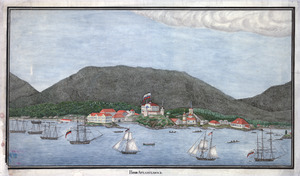
Other early settlements were built by fur trading companies. These include Fort Saint-James (1806) in British Columbia, Spokane House (1810) in Washington, and Fort Astoria (1811) in Oregon. Fort Vancouver (1824) was also a very important trading post.
There were also early settlements where Indigenous people and French Canadians lived together peacefully. These included French Prairie in Oregon and Frenchtown in Washington.
Border Disputes
Many countries claimed parts of the Pacific Northwest. Spain, Russia, Britain, and the United States all wanted control. Spain gave up its claims in 1794.
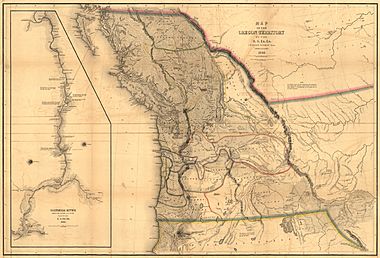
From the 1810s to the 1840s, the U.S. called the area the Oregon Country. Britain called it the Columbia District. Both countries claimed it. In 1846, the Oregon Treaty divided the region. The border was set along the 49th parallel. This line still separates the U.S. and Canada today.
The U.S. part became the Oregon Territory in 1848. Later, it was divided into Oregon and Washington territories. These became the states of Oregon, Idaho, and Washington. The Canadian part became the province of British Columbia in 1871.
Geology of the Pacific Northwest
The Pacific Northwest is a very active place geologically. This means it has both active volcanoes and faults (cracks in the Earth's crust).
The last big earthquake here was in 1700. It happened in the Cascadia subduction zone. Scientists know that huge earthquakes (magnitude 8 or higher) happen here about every 500 years. They often cause tsunamis.
Some active volcanoes in the region include Mount Garibaldi, Mount Baker, Mount Rainier, Mount St. Helens, Mount Adams, and Mount Hood.
Geography of the Pacific Northwest
The Pacific Northwest has many different landscapes. It's dominated by several mountain ranges. These include the Coast Mountains, the Cascade Range, and the Rocky Mountains.
The tallest peak is Mount Rainier in Washington, which is 14,410 feet (4,392 meters) high. East of the mountains are dry plateaus. The Columbia River cuts through these areas, creating deep canyons.
Because of lots of rain and mild summers, the Pacific Northwest has huge, green forests. These forests are full of Coast Douglas-fir trees, which are very tall. Some areas even have temperate rain forests.
The coastline has many fjords (long, narrow inlets), bays, and islands. The Salish Sea is a famous area with many islands, like Vancouver Island and the San Juan Islands.
Major cities like Vancouver, Portland, and Seattle started as seaports. They supported logging, mining, and farming. Now, they are big centers for technology and industry.
The Pacific Northwest has many beautiful national parks. In the U.S., these include Crater Lake in Oregon, and Olympic, Mount Rainier, and North Cascades in Washington. Canada has parks like Pacific Rim National Park and Gwaii Haanas National Park Reserve.
Climate in the Pacific Northwest
The climate in the Pacific Northwest is mostly mild with four seasons. However, mountainous and inland areas can be very different. Coastal areas have an oceanic climate, meaning mild temperatures and lots of rain. High mountains have an Alpine climate, which is cold and snowy.
East of the mountains, it's much drier. This is because the mountains block the rain, creating a "rain shadow" effect. Some coastal areas get a lot of rain, sometimes over 138 inches (3,500 mm) per year! Winters are usually mild for how far north the region is.
Population of the Pacific Northwest
Most people in the Pacific Northwest live in the big cities along the coast. The areas around Portland, Seattle, and Vancouver have over nine million people combined. Outside of these cities, the region is much less crowded. There are vast areas of mountains and forests with very few people.
Largest Cities in the Pacific Northwest
| City | State/Province | Population |
|---|---|---|
| Seattle | Washington | 704,000 |
| Portland | Oregon | 658,347 |
| Vancouver | British Columbia | 631,486 |
| Surrey | British Columbia | 598,530 |
| Burnaby | British Columbia | 257,926 |
| Boise | Idaho | 226,570 |
| Spokane | Washington | 222,081 |
| Richmond | British Columbia | 216,046 |
| Tacoma | Washington | 198,397 |
| Vancouver | Washington | 175,673 |
Economy of the Pacific Northwest
The Pacific Northwest has a strong and varied economy. Here are some of the main industries:
- Agriculture: This includes fruits, potatoes, wine, vegetables, and wheat.
- Aerospace: Companies like Boeing Commercial Airplane unit are here.
- Forestry: With so many forests, logging and wood products are important.
- Fishing: Salmon, halibut, and other shellfish are caught here.
- High Technology: This region is a major tech hub. Companies like Microsoft, Intel, and Amazon.com have their headquarters here.
- Hydroelectric Power: Dams on the Columbia River produce a lot of clean energy.
- Retail: Big stores like Costco and Starbucks started in the Pacific Northwest.
- Microbrewing: The region is famous for its craft beers and ciders.
- Outdoor Tourism: People come here for alpine skiing, hiking, kayaking, and fishing.
- Shoes and Apparel: Companies like Nike and Columbia Sportswear are based here.
Education in the Pacific Northwest
The Pacific Northwest has many colleges and universities. Here are some examples:
- In British Columbia: Universities like the University of British Columbia.
- In Idaho: Many colleges and universities.
- In Oregon: Schools like the University of Oregon and Oregon State University.
- In Washington: Universities like the University of Washington and Washington State University.
Culture of the Pacific Northwest
The main culture in the Pacific Northwest is from people of British and Scandinavian backgrounds. However, there's also a lot of Mexican and Chinese influence. For example, many people in Vancouver, British Columbia, speak Chinese. Indigenous culture is also very strong throughout the region.
Some people in the Pacific Northwest want the region to become its own country, called Cascadia. This is because of the shared environment and culture. However, the border between the U.S. and Canada is a strong division.
Caring for the Environment
People in the Pacific Northwest care a lot about the environment. Especially west of the mountains, you'll find lots of recycling and public transportation. Cities like Portland and Seattle are known for being very "green." Portland is even considered one of the most bicycle-friendly cities in the world.
Groups like Greenpeace started in Vancouver. They work to protect the environment. The Sea Shepherd Conservation Society, which protects oceans, has its headquarters in Washington.
Music Scene
The Pacific Northwest is famous for its music. It's known for indie music, especially grunge and alternative rock. Bands like Nirvana, Pearl Jam, and Foo Fighters came from here. The region also has a growing hip hop scene.
There are many music festivals, like Bumbershoot in Seattle and MusicfestNW in Portland. The Waterfront Blues Festival in Portland is one of the biggest blues festivals west of the Mississippi River.
Delicious Food
Foods typical of the Pacific Northwest include wild salmon, halibut, and various shellfish. You'll also find local fruits like huckleberries and marionberries. The region has many different kinds of food from around the world. Chinese, Japanese, Korean, Indian, and Mexican cuisines are very popular. In Seattle, Teriyaki restaurants are especially common.
The Pacific Northwest is also known for its local craft beers, ciders, and wines. Portland is a major center for microbreweries.
Sports and Fun
Outdoor activities are very popular here. People love alpine skiing, snowboarding, hiking, kayaking, and fishing.
The region has many professional sports teams. These include the Seattle Seahawks (football), Seattle Mariners (baseball), Portland Trail Blazers (basketball), and Vancouver Canucks (hockey). Soccer is also very popular, with teams like the Seattle Sounders FC, Portland Timbers, and Vancouver Whitecaps FC. These teams compete for the Cascadia Cup.
College sports are also a big deal, especially college football. The University of Washington Huskies and Washington State Cougars in Washington, and the University of Oregon Ducks and Oregon State Beavers in Oregon, have strong rivalries. Their fans are known for being very loud and passionate!
Video Games
Seattle is a major hub for video game companies. Microsoft, Valve, Bungie, and Nintendo of America all have headquarters in the Seattle area. EA Vancouver (part of Electronic Arts) is located in Vancouver, British Columbia. This makes the Pacific Northwest a very important place for the gaming world.
People and Languages
In the U.S. part of the region, Latinos work in agriculture and are a growing part of the workforce. African Americans are also a growing group, especially in cities like Tacoma, Seattle, and Portland.
British Columbia has a large Asian population, making up about 29% of the province. This includes people of East Asian, South Asian, and West Asian descent.
Most people in the Pacific Northwest speak Pacific Northwest English. This accent is often thought of as "neutral." Chinook Jargon was a special "trade language" used by Indigenous people and later by Europeans. It helped different groups communicate. Today, its influence is mostly seen in place names and a few local slang words. Chinese has been common since the gold rushes in the 1800s, especially in British Columbia. Punjabi is also common in British Columbia, especially in Vancouver, due to a large Punjabi Sikh population. Spanish is spoken in parts of Oregon, Washington, and British Columbia.
Beliefs and Spirituality
The Pacific Northwest has one of the lowest rates of church attendance in the U.S. Many people here say they have no religion. This is especially true west of the Cascade Mountains.
However, the region is also a place where many different spiritual beliefs are found. Some people follow Eastern spiritual practices like Tibetan Buddhism. There are also unique Christian communities like the Doukhobors and Mennonites. The Lower Mainland of British Columbia has a very large Sikh community.
See also
 In Spanish: Noroeste del Pacífico para niños
In Spanish: Noroeste del Pacífico para niños





